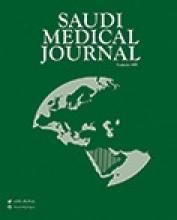Abstract
OBJECTIVE: To determine the load and importance of respiratory viruses in hospitalized Saudi children with acute lower respiratory tract infections (ALRIs).
METHODS: A retrospective study was performed at the Departments of Pediatrics, Pathology/Microbiology, King Khalid University Hospital, Kingdom of Saudi Arabia from January 2005 to December 2010. Nasopharyngeal aspirates were collected from 643 children with ALRI. Viruses were detected by direct immunofluorescence, respiratory syncytial virus (RSV), adenovirus (ADV), type 1 to 3 parainfluenza viruses (PIV), and type A and B influenza virus (flu).
RESULTS: Of the 643 children with ALRI, viruses were detected in 309 (48.1%) specimens. The viruses that were identified included RSV (n=295, 95.5%), PIV (n=8, 1.2%), ADV (n=2, 0.3%), flu A (n=2, 0.3%), and flu B (n=2, 0.3%). The RSV was predominated in 231 (75%) children less than one year of age. Only younger age and male gender were associated with severe illness. The peak frequency of the viruses detected was in the winter. Of the 309 virus positive samples, bronchiolitis was detected in 81.2% (n=251), and pneumonia in 14.2% (n=44) (p<0.0001).
CONCLUSION: Viruses are an important cause of ALRIs in Saudi children constituting approximately 48.1% of the total cases. The RSV is the most common pathogen (95.5%) causing ALRIs. Most of the children were younger than one year of age, and were more likely to present with bronchiolitis than pneumonia.
- Copyright: © Saudi Medical Journal
This is an open-access article distributed under the terms of the Creative Commons Attribution-Noncommercial License (CC BY-NC), which permits unrestricted use, distribution, and reproduction in any medium, provided the original work is properly cited.






